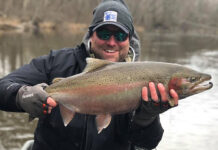With bellies full and hearts warmed by family festivities, hopefully the holidays provide the much needed time to recharge our minds and rejuvenate our spirits. With a new year quickly approaching, this time also allows us to reflect on the past and plan for the future.
In just five short days, we’ll be turning the page of our calendar over to a new year! What will 2014 bring? What challenges, adventures, struggles and triumphs await us? Ohio’s Soil and Water Conservation Districts confidently say, “Bring. It. On.”
Secret weapon
For approximately 70 years, Ohio’s 88 county soil and water conservation districts have been providing assistance to landowners, organizations, businesses and local and state government in the management of natural resources.
Since their formation, districts started strong and today remain the local go-to agencies and conservation leaders in each of their communities.
What are the secret weapons that make the soil and water conservation districts so successful?
Local leadership
To become established each county SWCD was formed by a vote of the people within that county. This was to ensure local ownership would address local issues.
Between 1943 and 1962, all 88 soil and water conservation districts were formed one by one throughout Ohio. Districts are led by five dedicated local residents who are elected and volunteer their time to serve staggered, three-year terms as board supervisors.
The strategic structure and design of districts enable the unique ability to provide landowners with education and conservation programs that address local needs, while advancing state and federal objectives for natural resource protection.
Prevalent partnerships
Since their inception, districts were formed as local government subdivisions to serve as liaisons between private landowners and federal agencies. Diversified funding and a broad base of partners allow districts to effectively do more with less.
Longevity
Decades have passed since the catastrophic Dust Bowl brought the public outcry and congressional action for soil and water conservation, yet conservation districts continue to stand the test of time.
Because of their proven ability to identify potential resource concerns and implement programs that protect our natural resources, districts have thrived and survived.
The primary purpose of all soil and water conservation districts is to bring people, governmental agencies, and private interests together to manage our natural resources and environmental challenges.
While resource priorities vary from county to county and will undoubtedly change over time, the need for a local entity to coordinate local natural resource objectives will never change.
Providing and protecting
From A (acid mine drainage) to Z (zebra mussels) and everything in between (take a deep breath here … aerial photos, agriculture, bioretention, compost, construction sites, crops, drainage, education, erosion, fertilizers, fish, forestry management, GIS, grazing, habitat, high tunnels, horses, invasive species, livestock, maps, mitigation, oil and gas, plan reviews, pollution, ponds, riparian protection, soil, streams, storm water, trees, watershed protection, wetlands, and wildlife, workshops) conservation districts provide information, offer technical assistance, and help others comply with current environmental regulations within their county.
As communities change, the land use changes and actions taken today impact our resources of tomorrow. Regardless of the current issues, districts are taking a proactive approach to meeting their growing communities’ needs, along with an increasing workload resulting from new state and federal requirements.
In addition to expanding assistance in traditional focus areas such as agriculture, districts have diversified to address emerging issues, including urban development, water quality, and everything in between. Protection of our natural resources regardless of land use, remains a priority.
From the beginning, districts have been willing and able to take on whatever local landscape impacts are waiting on the horizon.
Group effort
The Geauga Soil and Water Conservation District, for example, is heeding the call of the Ohio Phosphorus Task Force’s newly released report urging Ohioans to reduce all forms of phosphorus runoff by about 40 percent.
Nutrient loading and the resultant harmful algal blooms are posing a major threat to the water quality in all of Ohio’s waterways and especially Lake Erie.
In response to this emerging issue affecting the entire state, the Geauga SWCD was one of seven northeast Ohio SWCDs that joined forces in 2013 to again take a proactive approach. Together these districts formed the Lake Erie Central Basin Work Group and implemented an educational campaign urging urban homeowners, landscapers and recreation field managers to understand and limit fertilizer use.
This campaign was based on the national 4Rs Nutrient Stewardship Campaign (right fertilizer source, right application rate, right time and right place). Bringing awareness to the harmful algal blooms turning Lake Erie and many of our other lakes green, the theme “Green Isn’t Always Good” was born.
A series of educational brochures, posters, and bookmarks were created in both English and Spanish and then distributed throughout northeast Ohio and beyond.
Tackling tomorrow
The “Green Isn’t Always Good” initiative serves as just one example of the unique ability of soil and water conservation districts to proactively tackle locally-relevant natural resource issues.
By carrying the conservation message out of the state office and into the streets, schools, yards, and farms of our residents, districts are able to reach every corner of Ohio. We are digging in our heels and rolling up our sleeves for our current and future challenges.
Get ready to turn that calendar page and bring in the New Year. We’ve got some resolutions waiting!












